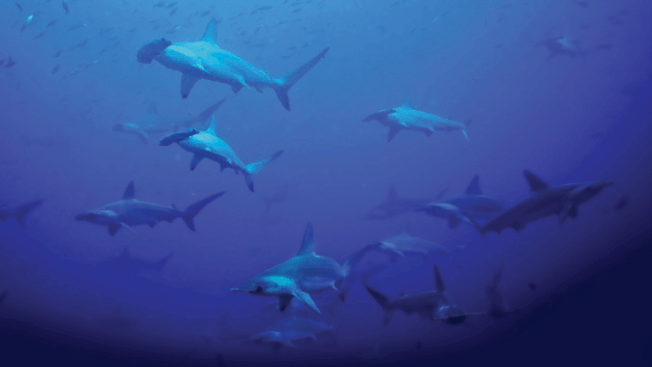
Going off the Deep End
 |
By: Sarah Rose
Scuba diving near a rock pinnacle, I look out into the blue and see a 12-foot shark with what seems like an inexplicably pointy head swimming toward me. As it nears and comes into focus, the image makes sudden sense: That is no point at all but rather a single round eye looking out sideways from a flat,T-bar skull. That eyeball is looking right at me.
Hammerheads are the circus freaks of the shark world. Scientists suspect they somehow "see" with their heads, navigating by Earth's magnetic field. They can detect an electrical signal of less than half a billionth of a volt; even our heartbeats are perceptible. I consider the few pounds I've put on over the holidays. Have I just fattened myself up for supper? These exquisitely sensitive sharks can be skittish, and though I know the rare attacks are made only in confusion or self-defense, my heart is thumping. The hammerhead passes so close I can count the gill slits – all five of them – and then I shut my eyes.
If I am to be eaten, I certainly am not going to watch.
On discovering I am still whole, I look around and see the sea bottom undulating with up to a hundred sharks. Hammerheads galore skim the sand in a beautiful and intimidating display.
If there is a middle of nowhere, then I have found it: Isla del Coco is a lone volcanic island some 350 miles off the Pacific coast of Costa Rica. From maps alone, this national park's singular charms are unapparent; but on inspection, you find that one of the largest uninhabited tropical islands on the planet is surrounded by some of the most densely populated seas.
Sharks of all stripes come to Cocos after mating in far deeper waters; the island is a way station at the intersection of several ocean currents. Cocos is also home to small, energetic yellow barber fish that love to feed on the parasitic copepods attached to the sharks; the barber fish offer relief with a thorough nit-picking of the shark's skin. Hammerheads, in particular, will school in the area by the hundreds for the treatments. Cocos, it turns out, is a shark spa.
We are taught to fear these beasts (or perhaps it's an evolutionary memory retained from the primordial soup; sharks, after all, are some of the oldest predators on Earth); and their very shape is thrilling and threatening, like a B-52 bomber. Cocos attracts not only the reef sharks that sleep all day like harmless house cats but also the deep-ocean travelers: the great hammerhead, Galapagos, and tiger sharks that have been known to munch on man.
Hammerheads circle up to our group and back down to the bottom in a cloud of barber fish. A juvenile shark swims below, trailing 20 feet of nylon fishing line. Though Cocos is a protected park, rogue fishermen cast lines miles long inside the park's boundaries, illegally hauling up sharks for their fins alone. As many as 73 million are killed annually worldwide to fuel the shark-fin soup trade. With filament looped around its neck, that young shark will keep growing, I later learn, until it eventually chokes to death. It is clear that humans attack sharks with far greater cruelty and frequency than sharks have ever hunted people.
I never want to leave this piece of ocean – and for too long, I don't – but I have to return to the boat. As I swim up,
I see flashes of silver – fish in the distance just at the edge of sight. The hammerhead school follows us, rising with our group, circling. They are curious; we are now the show. I surface, besotted. It feels like love. Shark and man have, however briefly, connected, and I am almost literally breathless: I have nearly emptied my tank.
I have often studied maps and considered the oceans – some two-thirds of the planet – as the blue space between destinations, that thing to get past en route to somewhere else. We hop on planes, skipping from landmass to landmass. Yet for most of the history of human travel, the ocean was a place in and of itself, an integral part of any journey. One of the greatest travel books ever written is about a whale named Moby Dick.
On an uninhabited island, I met the citizens of the sea in all their spine-tingling glory. From that so-called middle of nowhere, sharks reminded me the ocean was a destination, both fragile and full.